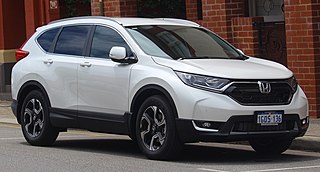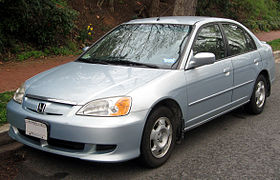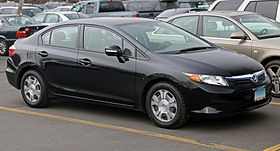
A hybrid vehicle is one that uses two or more distinct types of power, such as submarines that use diesel when surfaced and batteries when submerged. Other means to store energy include pressurized fluid in hydraulic hybrids.

The Honda CR-X, originally launched as the Honda Ballade Sports CR-X in Japan, is a front-wheel-drive sport compact car manufactured by Honda between 1983 and 1991. It was replaced by the Honda CR-X del Sol for the 1992 model year. Although there are many supposed definitions for the acronym CR-X, the most widely accepted is "Civic Renaissance Experimental".

The Honda Fit, also marketed as Honda Jazz, is a five-door B-segment supermini or subcompact car manufactured and marketed by Honda since 2001 and now in its fourth generation. Marketed worldwide and manufactured at ten plants in eight countries, sales reached almost 5 million by mid-2013.

The Honda Insight is a hybrid electric vehicle that was manufactured and marketed by Honda in its first generation as a two-door, two passenger liftback (1999–2006) and in its second generation as a four-door, five passenger liftback (2009–2014). In its third generation, it became a four-door sedan (2019–present). It was Honda's first model with Integrated Motor Assist system and the most fuel efficient gasoline-powered car available in the U.S. without plug-in capability — for the length of its production run.

The Honda CR-V is a compact crossover SUV manufactured by Japanese automaker Honda since 1995 and introduced in the North American market in 1997. It uses the Honda Civic platform with an SUV body design. The CR-V is Honda's mid-range utility vehicle, slotting between the smaller Honda HR-V and the larger North American market Honda Pilot. Honda states "CR-V" stands for "Comfortable Runabout Vehicle," while the term "Compact Recreational Vehicle" is used in a British car review article that was republished by Honda.

The L-series is a compact inline-four engine created by Honda, introduced in 2001 with the Honda Fit. It has 1.2 L (1,198 cc), 1.3 L (1,318 cc) and 1.5 litres (1,497 cc) displacement variants, which utilize the names L12A, L13A and L15A. Depending on the region, these engines are sold throughout the world in the 5-door Honda Brio Fit/Jazz hatchback Honda Civic and the 4-door Fit Aria/City sedan. They are also sold in the Japanese-only Airwave wagon and Mobilio MPV.

The Honda R engine is an inline-four engine launched in 2006 for the Honda Civic (non-Si). It is fuel injected, has an aluminum-alloy cylinder block and cylinder head, is a SOHC 16-valve design and utilizes Honda's i-VTEC system. The R series engine has a compression ratio of 10.5:1, features a "drive by wire" throttle system which is computer controlled to reduce pumping losses and create a smooth torque curve.
Hybrid vehicle drive trains transmit power to the driving wheels for hybrid vehicles. A hybrid vehicle has multiple forms of motive power.

The Honda CR-Z is a sport compact hybrid electric automobile manufactured by Honda from 2010 to 2016. It was marketed as a "sport hybrid coupe." The CR-Z combines a hybrid gasoline-electric powertrain with traditional sports car elements, including 2+2 seating arrangement (excluding North American models where the backseat is removed) and a standard 6-speed manual transmission. The CR-Z is successor to the second generation Honda CR-X in both name and exterior design.

The fifth generation Honda Civic debuted in Japan on September 9, 1991. At its introduction, it won the Car of the Year Japan award for the second time. Fifth generation cars were larger than their predecessors, had more aerodynamic bodies, and the wheelbase was increased to 257 cm (101.3 inches)—for the three-door hatchback—and to 262 cm (103.2 inches)—for the four-door sedan. The Civic Shuttle station wagon was not part of the fifth generation and was dropped for overseas markets, while the previous generation wagon continued in Japan and Europe.

The seventh generation Honda Civic is an automobile which was produced by Honda from 2000 to 2005. It was released in September 2000 as a 2001 model. Compared to its predecessor, it retained similar exterior dimensions, but increased significantly in interior space thus bumping up Civic to a compact car size segment. There was a flat rear floor, giving better comfort to the rear seat passengers. This generation abandoned the front double wishbone suspension, which had been used in the fourth to sixth generations, replacing it with MacPherson strut. The seventh generation was the last to offer 4WD variants.

The eighth generation Honda Civic was introduced in September 2005, for the 2006 model year. This generation introduced the "two-tier" instrument panel. In many countries, all models come standard with power windows, anti-lock brakes (ABS), and side/curtain airbags. Additionally, the 2006 models acquired ULEV-2 certification and boast a more powerful 1.8-litre engine than the 2005 counterparts while retaining almost equal fuel economy.
Honda Advanced Technology is part of Honda's long-standing research and development program focused on building new models for their automotive products and automotive-related technologies, with many of the advances pertaining to engine technology. Honda's research has led to practical solutions ranging from fuel-efficient vehicles and engines, to more sophisticated applications such as the humanoid robot, ASIMO, and the Honda HA-420 HondaJet, a six-passenger business jet.

In the U.S., the seventh generation North American Honda Accord is a mid-size car that was available from 2002 to 2007, in both coupe and sedan styles. The sedan was also marketed as the Honda Accord in parts of Latin America, Asia, Middle East, Caribbean, Australia and New Zealand markets, also being related to the Honda Inspire available in Japan from 2003. The North American Honda Accord, with modifications for local market needs, was the launch vehicle of Honda in the South Korean market with sales beginning from May 20, 2004.

The ninth generation Honda Civic was launched in the North American market in April 2011, Europe in February 2012 and Asia-Pacific in early 2012.

The Acura ILX is a subcompact executive car produced by Honda under the Acura brand. All ILX variants are based upon the ninth-generation Civic sedan. The larger compact ILX replaced the subcompact Canadian market exclusive Acura CSX. The ILX also replaced the Acura TSX in both the Canadian and United States markets upon its discontinuation for the 2015 model year as Acura's compact sedan. The ILX was also Acura's first gasoline-electric hybrid vehicle.

The Acura RLX is a luxury/executive car manufactured by Honda and sold under their Acura division, released in 2013, succeeding the RL. The RLX was discontinued in 2020.

The Hyundai Ioniq is a compact five door liftback manufactured and marketed by Hyundai. The nameplate Ioniq is a portmanteau of ion and unique. It is the first automobile to be offered in hybrid, plug-in hybrid, and all-electric variants with no "standard" internal combustion engine only version.

The ninth generation Honda Accord is a mid-size car introduced in 2012 by Honda, and received a refreshed front fascia, grill, head lights, rear lights, and alloy wheel designs for the 2016 model year. With the discontinuation of smaller European and Japanese market Accord in 2015, the larger North American Accord became the only version in production, with the Hybrid version taking over as the flagship of Honda's automotive product in many markets that once received the smaller Accord.

The second generation Honda Fit is a subcompact car or supermini manufactured by Honda since 2007. It debuted on 17 October 2007 at the 40th Tokyo Motor Show.

































